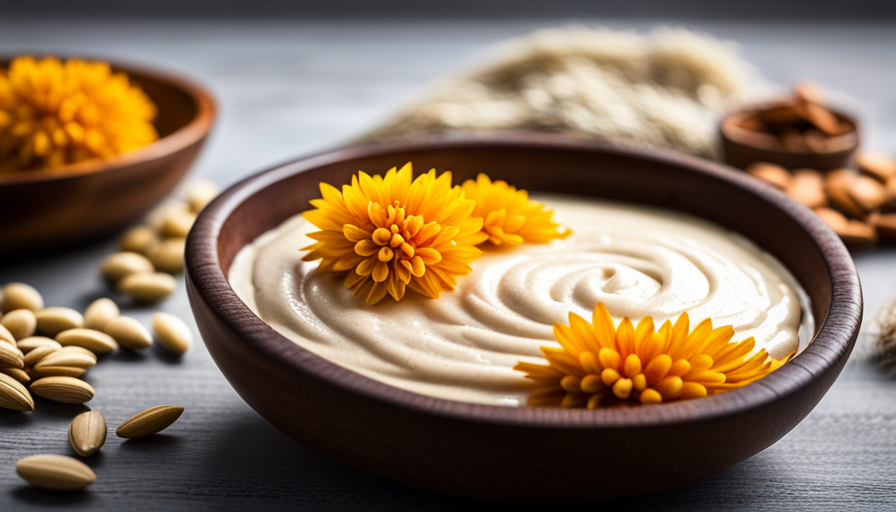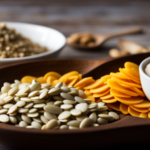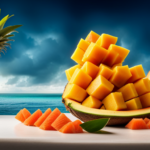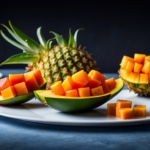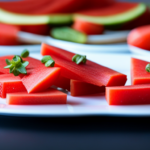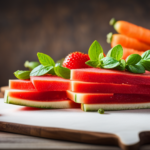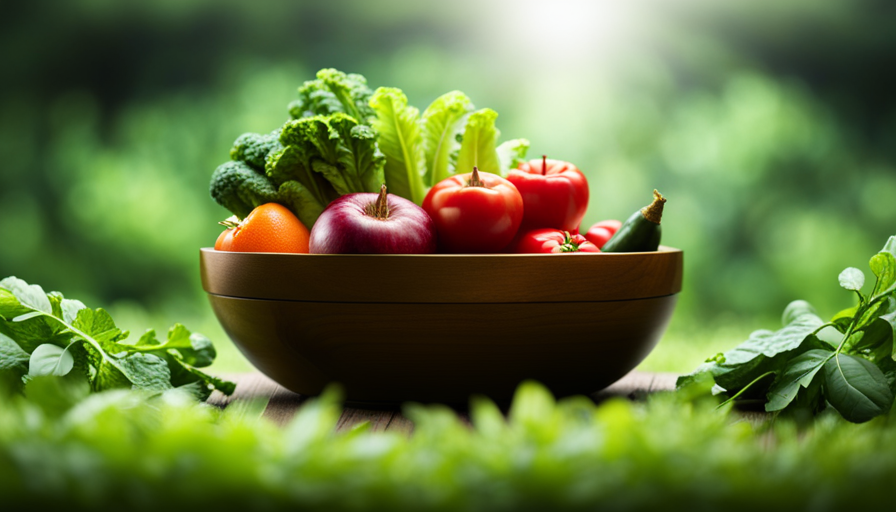Are you interested in adding a unique touch to your raw food recipes? Get ready, because we’re about to go on a wild and nutty journey!
Picture this: you’re all set to whip up a deliciously creamy dish, but alas, you realize you’re fresh out of cashews. Fear not, dear reader, for I have a secret to share with you.
In the world of raw food recipes, there exists a multitude of alternatives that can turn your culinary dreams into a reality. From almonds to avocados, macadamia nuts to pumpkin seeds, the possibilities are as endless as your imagination.
So, whether you’re seeking a nutty flavor, a creamy texture, or simply want to explore new horizons, join me on this tantalizing journey as we uncover the perfect substitutes for cashews. Get ready to ignite your taste buds and nourish your body with these innovative, health-conscious ingredients.
Let’s dive in and discover the wonders that await in the realm of raw food substitutions!
Key Takeaways
- Almonds, macadamia nuts, Brazil nuts, sunflower seeds, pumpkin seeds, and sesame seeds can be used as alternatives to cashews in raw food recipes.
- These substitutes offer different flavors and textures, such as the crunchiness of almonds, the creaminess of macadamia nuts, and the nuttier flavor of Brazil nuts.
- Sunflower seeds, pumpkin seeds, and sesame seeds provide a satisfying crunch and are packed with various nutrients like vitamin E, magnesium, zinc, and omega-3 fatty acids.
- Other options for creaminess in raw food recipes include coconut cream, silken tofu, Greek yogurt, avocado, coconut meat, banana, mango, and pineapple.
Almonds as a Cashew Alternative
If you’re looking for a tasty cashew alternative, almonds are a fantastic option! When it comes to almonds vs cashews, there are some key differences to consider. Almonds have a slightly different flavor profile, with a subtle nuttiness and a hint of sweetness. They also have a crunchier texture compared to the creaminess of cashews.
But don’t let that deter you, because almonds bring their own set of health benefits to the table. Almonds are packed with essential nutrients that are beneficial for your overall health. They’re a great source of vitamin E, which acts as a powerful antioxidant, protecting your cells from damage caused by free radicals. Almonds also contain healthy fats, such as monounsaturated fats, which help to lower bad cholesterol levels and reduce the risk of heart disease. Additionally, they’re rich in fiber, which aids in digestion and helps you feel fuller for longer.
Incorporating almonds into your raw food recipes not only adds a delicious nutty flavor but also boosts the nutritional value of your meals. You can use them as a base for creamy sauces or dressings, or even blend them into a smooth and creamy almond butter. So why not give almonds a try? They’re a versatile and nutritious alternative to cashews that’ll satisfy your taste buds and support your overall well-being.
Macadamia Nuts for Creaminess
To achieve a creamy texture in your dishes, consider using macadamia nuts as a delightful alternative to cashews. Macadamia nuts are not only rich and buttery but also offer a wide range of health benefits. They are packed with monounsaturated fats, which are heart-healthy and can help lower cholesterol levels. Additionally, macadamia nuts are a good source of fiber, protein, and essential minerals like magnesium and manganese.
When substituting cashews with macadamia nuts in raw food recipes, you can create a delicious macadamia nut butter that serves as a spread alternative. Simply blend roasted macadamia nuts until they reach a creamy consistency, and you’ll have a versatile and flavorful spread to use in sandwiches, toast, or as a dip for fruits and vegetables.
Macadamia nuts can also be used in baking recipes to add a creamy and nutty flavor. They work well in cookies, cakes, and even pie crusts. Their natural sweetness and rich texture make them an excellent choice for creating delectable desserts that are both indulgent and nutritious.
Here is a visual representation of different ways you can use macadamia nuts in your recipes:
| Macadamia Nut Recipes |
|---|
| Macadamia Nut Butter |
| Macadamia Nut Cookies |
| Macadamia Nut Crust |
| Macadamia Nut Cake |
So, the next time you’re looking for a creamy substitute for cashews, give macadamia nuts a try. Your taste buds and your health will thank you!
Brazil Nuts for a Nutty Flavor
When you’re craving a rich and nutty flavor in your dishes, Brazil nuts are a fantastic choice. They not only add a delightful crunch but also bring a unique taste that sets them apart from other nuts. Here are three reasons why Brazil nuts are the perfect substitute for cashews in your raw food recipes:
-
Brazil nuts vs almonds for a nutty flavor: While almonds are undoubtedly delicious, Brazil nuts have a distinct flavor that’s nuttier and more robust. When used in recipes, Brazil nuts add a depth of flavor that can elevate your dishes to new heights. Their rich taste is perfect for creating nut-based sauces, creamy dressings, or even as a topping for desserts.
-
The benefits of using macadamia nuts over cashews: Macadamia nuts are often used as a substitute for cashews due to their similar creamy texture and mild flavor. However, Brazil nuts offer an alternative that brings a unique twist to your recipes. Not only do they provide a nutty flavor, but they also offer a range of health benefits. Brazil nuts are an excellent source of selenium, a mineral that supports immune function and may even help reduce inflammation.
-
Creative ways to incorporate Brazil nuts: Don’t limit yourself to using Brazil nuts as a simple snack or topping. Get creative and explore the possibilities! Try blending them into a creamy Brazil nut milk, or use them as a base for a delicious nut-based cheese. You can also chop them up and sprinkle them over salads or use them to add a delightful crunch to your raw desserts.
Brazil nuts are a wonderful substitute for cashews in raw food recipes. They bring a nutty flavor, offer health benefits, and provide endless possibilities for culinary creativity. So go ahead and give Brazil nuts a try – your taste buds will thank you!
Sunflower Seeds for Texture
Looking to add a satisfying crunch to your dishes? Sunflower seeds are the secret ingredient you need. Not only are they a delicious and versatile addition to raw food recipes, but they also offer a wide range of health benefits.
Let’s start by addressing any concerns about sunflower seed allergies. While allergies to sunflower seeds do exist, they are relatively rare compared to other nuts and seeds. If you or someone you’re cooking for has a sunflower seed allergy, it’s important to avoid using them as a substitute for cashews. However, if allergies are not a concern, sunflower seeds can be an excellent alternative.
One of the main benefits of using sunflower seeds in raw food recipes is their nutritional value. They are packed with essential nutrients like vitamin E, magnesium, and selenium, which can support heart health and boost your immune system. Additionally, sunflower seeds are a great source of healthy fats, protein, and fiber, making them a satisfying and nutritious ingredient.
To give you a better idea of the benefits of sunflower seeds, here is a table highlighting their nutritional content:
| Nutrient | Amount per 100g |
|---|---|
| Vitamin E | 35.17 mg |
| Magnesium | 325 mg |
| Selenium | 53 µg |
| Healthy Fats | 51.5 g |
| Protein | 20.78 g |
Incorporating sunflower seeds into your raw food recipes not only adds a delightful crunch but also provides numerous health benefits. So go ahead and get creative in the kitchen with this innovative ingredient!
Pumpkin Seeds for a Nut-Free Option
If you’re craving a crunchy and nut-free option, pumpkin seeds are like tiny bursts of flavor that’ll elevate your dishes. They’re not only delicious but also offer a wide range of health benefits.
Pumpkin seeds are packed with nutrients like magnesium, zinc, and omega-3 fatty acids, making them a great addition to any raw food recipe.
One way to incorporate pumpkin seeds into your raw food dishes is by using pumpkin seed butter as a substitute for cashews. Pumpkin seed butter has a rich and creamy texture that mimics the smoothness of cashew butter. You can use it as a base for dressings, dips, or even as a spread on your favorite raw crackers.
If you’re looking for a different twist, sesame seeds can also be used as an alternative to cashews in raw food recipes. They provide a similar nutty flavor and can be ground into a paste to create a creamy texture. Sesame seed butter, also known as tahini, is a popular ingredient in Middle Eastern cuisine and can be used in a variety of raw food dishes.
So, whether you choose pumpkin seed butter or sesame seeds as a substitute for cashews, you can enjoy the same creamy texture and nutty flavor in your raw food recipes. Get creative and innovative with your dishes, and indulge in the health-conscious goodness of these delicious alternatives.
Coconut Cream for Creaminess
For a creamy and indulgent twist, coconut cream is a fantastic option to add richness to your dishes. Not only does it provide a luscious texture, but it also brings a delightful tropical flavor to your raw food recipes.
Here are four reasons why coconut cream is an excellent substitute for cashews:
-
Creaminess: Coconut cream is known for its creamy consistency, similar to that of cashews. It blends smoothly into sauces, soups, and desserts, giving them a velvety texture that’ll leave your taste buds satisfied.
-
Dairy-free: If you’re looking for a dairy-free alternative, coconut cream is your go-to choice. It’s perfect for those with lactose intolerance or following a vegan lifestyle.
-
Coconut cream vs. coconut milk: While coconut milk is thinner in texture, coconut cream is thicker and richer. If you want a more indulgent and decadent flavor, opt for coconut cream.
-
Homemade coconut cream vs. store-bought options: You can make your own coconut cream by refrigerating a can of full-fat coconut milk. This way, you have control over the ingredients and can avoid any additives or preservatives found in store-bought options.
Incorporating coconut cream into your raw food recipes will not only elevate the taste but also add a healthy touch of tropical goodness. So go ahead and experiment with this versatile substitute for cashews!
Silken Tofu for Creamy Texture
Silken tofu creates a velvety smoothness that transports your taste buds to a creamy paradise. This versatile ingredient is a game-changer for vegan desserts and can be used as a substitute for cashews in raw food recipes. Not only does it provide a creamy texture, but it also adds a healthy twist to your dishes.
When it comes to creating creamy desserts, silken tofu is your secret weapon. It’s smooth and custard-like consistency makes it an ideal base for puddings, mousses, and even cheesecakes. Blend it with your favorite fruits, such as strawberries or mangoes, and you’ll have a luscious treat that satisfies your sweet tooth without compromising on taste.
But silken tofu isn’t just limited to desserts. It can also be used as an alternative plant-based source of creaminess in savory raw food recipes. Whether you’re making a creamy sauce for pasta or a vegan mayonnaise, silken tofu can be blended with other ingredients to create a rich and creamy texture.
What makes silken tofu even more appealing is its health benefits. It’s low in calories, high in protein, and contains essential amino acids. It’s also a good source of calcium, iron, and magnesium. So not only does it give you that creamy satisfaction, but it also nourishes your body.
Next time you’re in need of a creamy substitute for cashews in your raw food recipes, give silken tofu a try. Its velvety smoothness and versatility will take your dishes to a whole new level of deliciousness.
Greek Yogurt for Creaminess and Protein
Greek yogurt is a creamy and protein-packed ingredient that adds a delightful richness to a variety of dishes. Not only does it taste amazing, but it also offers numerous health benefits.
Here are three reasons why you should consider using Greek yogurt as a substitute for cashews in your raw food recipes:
-
Gut Health: Greek yogurt is known for its gut-friendly properties. It contains live and active cultures that act as probiotics, promoting a healthy balance of bacteria in your digestive system. By incorporating Greek yogurt into your recipes, you can support your gut health and improve digestion.
-
Probiotic Source: When it comes to probiotics, Greek yogurt is a superstar. It is a fantastic source of beneficial bacteria that can help boost your immune system and improve overall gut function. By using Greek yogurt instead of cashews in your recipes, you not only get a creamy texture but also a natural probiotic boost.
-
Creaminess and Protein: Greek yogurt is renowned for its creamy texture, making it a perfect substitute for cashews. It adds a luscious mouthfeel to your dishes without the need for additional fats. Additionally, Greek yogurt is packed with protein, which is essential for building and repairing tissues in your body.
So, whether you’re looking to enhance the creaminess of your raw food recipes or reap the benefits of gut-friendly probiotics, Greek yogurt is an excellent choice as a substitute for cashews. Give it a try and enjoy the delicious and health-conscious twist it adds to your dishes.
Avocado for Creaminess and Healthy Fats
If you’re looking for a creamy and healthy substitute for cashews in your raw food recipes, look no further than the versatile avocado. Not only does it add a rich and velvety texture to your dishes, but it also provides a dose of healthy fats that are essential for a well-balanced diet.
Avocados are a great source of monounsaturated fats, which are known to promote heart health and help lower bad cholesterol levels. They also contain a variety of vitamins and minerals, including potassium, vitamin K, vitamin E, and vitamin C.
To showcase the benefits of using avocados in your raw food recipes, let’s explore some other fruits and vegetable alternatives that can also provide creaminess and healthy fats. Check out the table below for some ideas:
| Fruit Alternatives | Vegetable Alternatives |
|---|---|
| Coconut meat | Cauliflower |
| Banana | Sweet potato |
| Mango | Butternut squash |
| Pineapple | Zucchini |
These alternatives can be blended or mashed to create a smooth and creamy texture, similar to cashews. So why not try experimenting with these options and create delicious and nutritious raw food recipes that are both satisfying and good for you?
Nut-Free Seed Butter as a Versatile Substitute
Looking for a versatile and nut-free option for adding creaminess to your dishes? Look no further than seed butter, a delicious and healthy alternative that can elevate your culinary creations.
Nut-free spreads made from seeds like sunflower, pumpkin, or sesame are becoming increasingly popular in the world of raw food recipes. Not only do they provide a creamy texture, but they also offer a wide range of flavors that can take your dishes to the next level.
Sunflower seed butter, for example, has a rich and nutty taste that pairs well with both sweet and savory dishes. Its smooth consistency makes it a perfect substitute for cashews in recipes like cheesecakes, sauces, and dressings.
Pumpkin seed butter, on the other hand, brings a slightly earthy and slightly sweet flavor to your dishes. It can be used to add depth and richness to soups, smoothies, and even energy bars.
And let’s not forget about sesame seed butter, also known as tahini, which lends a unique and slightly bitter taste to your recipes. It works wonders in dips, spreads, and even as a base for raw desserts.
With these nut-free spreads at your disposal, the possibilities are endless. So get creative, experiment with different flavors, and enjoy the creamy goodness that seed butter brings to your raw food recipes.
Frequently Asked Questions
Are there any other nuts that can be used as a substitute for cashews in raw food recipes?
When it comes to raw food recipes, you may wonder if almond butter is a better choice than cashews. Well, both have their merits. Almond butter is rich in healthy fats and provides a smooth and creamy texture.
On the other hand, cashews offer a slightly sweeter taste and a buttery consistency. As for substituting cashews in raw food desserts, pistachios can be a fantastic option. They bring a unique flavor and a delightful crunch to your creations.
So, get creative and give pistachios a try!
Can coconut cream be used as a replacement for cashews in all types of recipes?
Coconut cream can definitely be a tasty replacement for cashews in various raw food recipes. Cashews have a creamy and nutty taste, while coconut cream brings a unique tropical flavor to the table. In terms of texture, cashews are smoother and buttery, whereas coconut cream is thicker and more velvety. To successfully use coconut cream as a cashew substitute, try blending it with other ingredients to achieve a similar creamy consistency. Experiment with different ratios and add a touch of sweetness or acidity to enhance the flavors. Get creative and enjoy the health-conscious possibilities!
Is Greek yogurt a suitable alternative for cashews in raw food recipes?
Greek yogurt can be a great alternative for cashews in raw food recipes. Did you know that Greek yogurt’s packed with protein, making it a healthy choice? Not only does it provide a creamy texture, but it also adds a tangy flavor to your dishes. If you’re looking for other options, almond milk’s another suitable substitute. Its creamy consistency works well in many recipes. Tofu can also be used as a replacement, offering a mild flavor and smooth texture.
Can avocado be used as a cashew substitute in both sweet and savory raw food recipes?
Yes, avocado can be a fantastic substitute for cashews in both sweet and savory raw food recipes. Its creamy texture and mild flavor make it a versatile ingredient.
In sweet recipes, avocado adds a luscious richness to desserts like puddings and ice creams.
In savory dishes, it can be used to make creamy sauces, dressings, and even cheese alternatives.
Plus, avocados are packed with healthy fats and nutrients, making them a nutritious choice for your raw food creations.
What are some other nut-free options for replacing cashews in raw food recipes?
Looking for nut-free options to replace cashews in your raw food recipes? Look no further! There are plenty of innovative and health-conscious alternatives to choose from.
Consider using sunflower seeds, which offer a creamy texture and mild flavor. Another option is hemp seeds, known for their nutty taste and high protein content. If you’re looking for a unique twist, try using white beans for a creamy and nutritious substitute.
Don’t let a nut allergy hold you back from enjoying delicious raw food creations!
Can I Use Other Nuts as a Substitute for Cashews in Raw Food Recipes?
Yes, you can use other nuts like almonds, walnuts, or macadamias as a substitute for cashews in raw desserts food processor recipes. Each nut will lend a unique flavor and texture to your dishes, so feel free to experiment and find the perfect replacement for your recipe.
Conclusion
So there you have it, a plethora of options to substitute for cashews in your raw food recipes. Whether you choose almonds for their crunch, macadamia nuts for their creaminess, or sunflower seeds for their texture, you can’t go wrong.
And don’t forget about the nut-free options like pumpkin seeds or silken tofu. If you’re looking for a creamy and protein-packed alternative, Greek yogurt is the way to go. And for those seeking healthy fats, avocado or nut-free seed butter will do the trick.
With these substitutes, your raw food creations will be both innovative and health-conscious, satisfying your taste buds and nourishing your body. So get creative in the kitchen and enjoy the benefits of these delicious alternatives.

